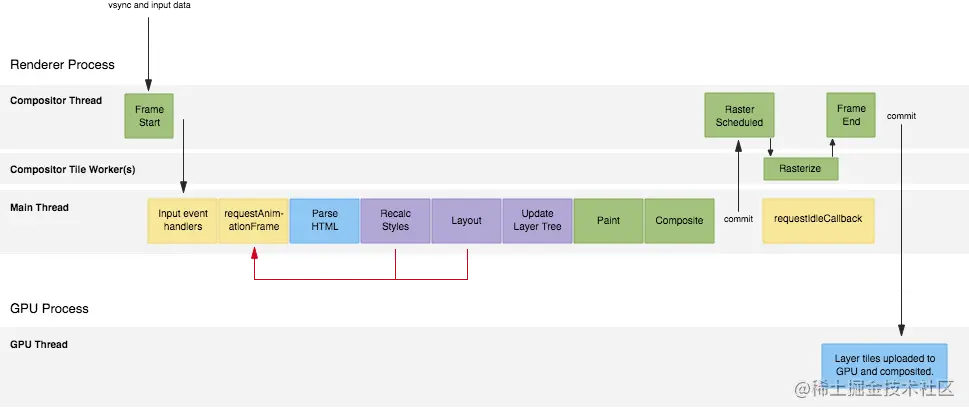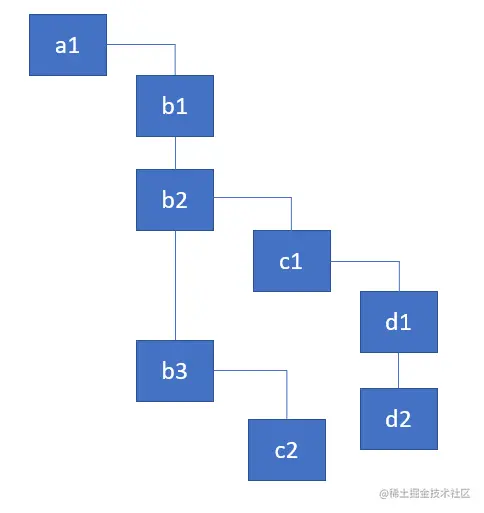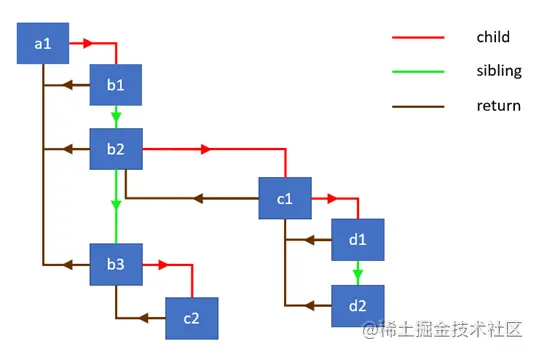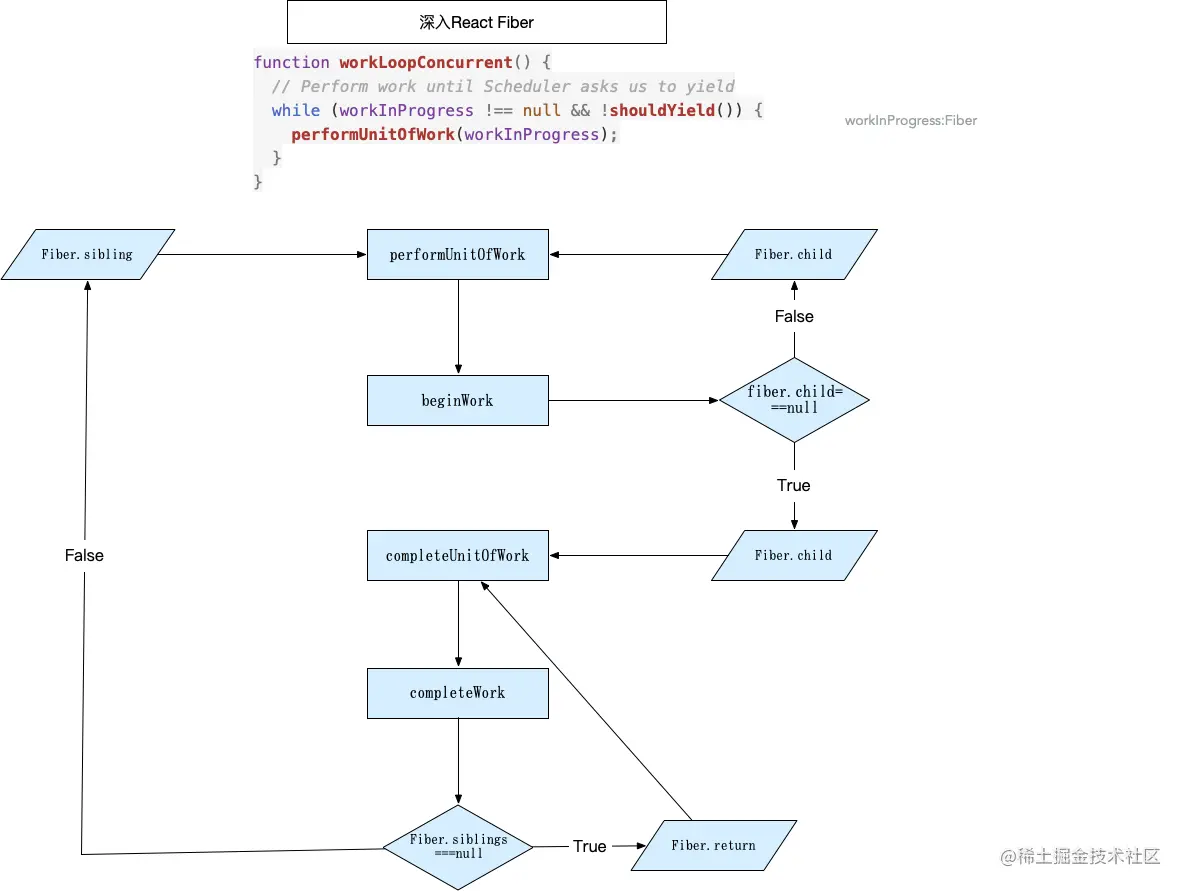-
React源码解读之React Fiber
开始之前,先讲一下该文章能帮你解决哪些问题?
- facebook为什么要使用重构React
- React Fiber是什么
- React Fiber的核心算法 - react是如何中断重启任务的
- react fiber部分源码简化版
前言
该文章涉及的源码部分基于React v17.0.2
why React Fiber
- 浏览器渲染过程
从浏览器的运行机制谈起。大家都知道,浏览器是多进程多线程的,多进程包括主进程,渲染进程,插件进程,GPU进程等,作为前端开发者,我们主要关注其中的渲染进程,这里是页面渲染,HTML解析,css解析,js执行所在的地方。在渲染进程中包括多个线程,此次核心关注页面渲染的两个线程,GUI线程和JS线程。
GUI线程负责浏览器界面的渲染,包括解析HTML,CSS,布局绘制等;js线程包含我们通常编写的js代码的解析引擎,最有名的就是google的V8。需要注意的一点是,js引擎和GUI渲染是互斥的,因为JS可能会更改HTML或者CSS样式,如果同时执行会导致页面渲染混乱,所以当JS引擎执行时,GUI渲染线程会被挂起,等JS引擎执行完立即执行。
- GPU渲染
我们通常看到的动画,视频本质上是通过一张张图片快速的闪过,欺骗人类的双眼,让人以为是连续的动画,每秒内包含的图片越多动画越流畅,正常60张图片可以让人眼感觉是流畅的动画,所以当前大部分设备的FPS是60,即,每秒60帧。所以Chrome要在16ms的时间内执行完下图的渲染任务,才能让用户感觉不到掉帧。

所以,如果JS执行时间过长,基本上超过10ms之后,用户会感觉到明显的卡顿,很影响用户体验(下文中js执行都以16ms为分界点,不计算后续的渲染,实际的可执行时间肯定小于16ms)。而React执行是要进行两棵树的diff,虽然React根据html的特性对diff算法做了优化,但是如果两棵树比对的层级较深,依旧会远远超过16ms。
React Fiber
基于此,那如何解决问题呢?在上图中,React作为js,所有的同步操作执行在最开始,在React执行完成后,后续的html解析,布局渲染等操作才会执行。最容易想到的就是,优化JS的执行速度,把React占用线程的时间缩短到16ms以内。在React执行中,最耗时的就是diff算法,React针对html这种场景下做了优化,业界已经没有更好的算法可以缩短diff算法的时间,所以当树的层次很深时,执行时间依旧很长。
那还有什么办法呢,我们依旧可以看上图,在现代浏览器中,浏览器为了让开发者知道浏览器执行完当前帧所有的操作后,还有多长时间可以使用,提供了requestIdleCallback这么一个方法,据此我们可以知道当前还有多长时间可以执行。
requestIdleCallback
requestIdleCallback((deadline) => { while ((deadline.timeRemaining() > 0 || deadline.didTimeout) && nextComponent) { nextComponent = performWork(nextComponent); } });- 1
- 2
- 3
- 4
- 5
题外话:
有兴趣可以在控制台执行输出一下requestIdleCallback回调参数的requestIdleCallback((deadline) ,在不同的网页上得到的时间可能不同。甚至可能会超过16ms(在React官网就显示49.9ms)因为requestIdleCallback的一些限制原因,React源码中未使用requestIdleCallback,而是自己实现了一套类似的机制。
使用此方法我们知道每帧的剩余时间之后,这样就可以在剩余时间内进行工作,如果当前帧时间不够,就把剩余的工作放到下一帧的requestIdleCallback中执行。这就是React所说的时间切片(time slicing)。
所以要使用此方法,需要把基于js内置栈调用的同步递归遍历的diff算法改为异步增量更新。按照React负责人的说法就是
如果你仅仅依赖js内置的调用栈,它会一直执行直到栈为空…,如果我们可以任意的中断并且手动的操作调用栈,不是更完美吗?这就是React Fiber的目的。Fiber是针对React Component的栈的重新实现。你可以认为一个Fiber就是一个虚拟的栈中的一项任务。
说人话,就是原来树的递归是深度递归遍历,现在需要把递归算法重新实现,以便于我不依赖于栈的调用,可以对react组件一个一个节点的遍历,中途任意时间可以中断和从当前开始。相关参考视频讲解:进入学习
stack Reconciliation vs Fiber Reconciliation
stack Reconciliation
假如我们有如下一个html结构

转化成类React组件的js对象如下
const a1 = {name: 'a1'}; const b1 = {name: 'b1'}; const b2 = {name: 'b2'}; const b3 = {name: 'b3'}; const c1 = {name: 'c1'}; const c2 = {name: 'c2'}; const d1 = {name: 'd1'}; const d2 = {name: 'd2'}; a1.render = () => [b1, b2, b3]; b1.render = () => []; b2.render = () => [c1]; b3.render = () => [c2]; c1.render = () => [d1, d2]; c2.render = () => []; d1.render = () => []; d2.render = () => [];- 1
- 2
- 3
- 4
- 5
- 6
- 7
- 8
- 9
- 10
- 11
- 12
- 13
- 14
- 15
- 16
- 17
正常情况,我们会使用像下面这种方式递归来遍历这棵"树",在React最早的版本就是基于此来递归遍历dom树
function walk(instance) { console.log(instance.name); let children = instance.render(); children.forEach((child) => { walk(child); }); } walk(a1);- 1
- 2
- 3
- 4
- 5
- 6
- 7
- 8
可以看到,这种方式,是可以遍历完整棵树,可是它没办法做到我们之前所说的中断递归,如果你中途中断了递归这棵树,下次你要重新从根节点整个遍历。这显然是不行的,它只能不断递归遍历,直到stack调用栈为空。那React Fiber是如何中断重启任务呢?
答案是单链表树遍历算法。简单来说就是把原来树本身的嵌套结构,改为单链表形式的树。
Fiber Reconciliation
React具体是如何使用链表遍历树呢?为了实现这种算法,首先先看下我们需要的数据结构
- child,指向该节点第一个子节点
- sibling,指向该节点的下一个兄弟节点
- return,指向该节点的父节点
还是之前的dom树结构,现在变成了这样

构建Fiber树的过程就不描述了,我们直接看遍历算法(父节点优先,深度优先)
let root = fiber; let node = fiber; while (true) { if (node.child) { node = node.child; continue; } if (node === root) { return; } while (!node.sibling) { if (!node.return || node.return === root) { return; } node = node.return; } node = node.sibling; }- 1
- 2
- 3
- 4
- 5
- 6
- 7
- 8
- 9
- 10
- 11
- 12
- 13
- 14
- 15
- 16
- 17
- 18
可以看到,拿到根节点后,不断遍历子节点,直到最深节点,然后从最深的子节点开始遍历兄弟节点,如果没有兄弟节点就返回该节点父节点,如果有兄弟节点,把每个兄弟节点的子节点遍历完,直到最后一个子节点,然后返回父节点。这样不断遍历,直到返回根节点。
下面是在React源码中Fiber的数据对象。其实说到底,Fiber就是一个对象。他相对于之前React createElement生成的element对象,多了一层数据结构来支撑上述的单链表遍历算法。
Fiber数据结构
下面是React源码中的Fiber对象的属性,具体可以直接看注释。
function FiberNode( tag: WorkTag, pendingProps: mixed, key: null | string, mode: TypeOfMode ) { // Instance this.tag = tag; //Fiber标记是什么类型的Fiber/component,WorkTag 0-24 this.key = key; // 唯一标识 this.elementType = null; this.type = null; this.stateNode = null; //stateNode:class div // Fiber 数据结构 this.return = null; // 父节点 this.child = null; // 第一个子节点 this.sibling = null; // 兄弟节点 this.index = 0; // this.ref = null; this.pendingProps = pendingProps; //newprops this.memoizedProps = null; // oldProps 上次的props // updateQueue数据结构: // { // baseState: fiber.memoizedState, // firstBaseUpdate: null, // lastBaseUpdate: null, // shared: { // pending: null, // interleaved: null, // lanes: NoLanes, // }, // effects: null, // }; this.updateQueue = null; // 批处理队列 this.memoizedState = null; //oldState this.dependencies = null; this.mode = mode; // Effects this.flags = NoFlags; // 标记该fiber变更方式 this.subtreeFlags = NoFlags; this.deletions = null; // 优先级调度 this.lanes = NoLanes; this.childLanes = NoLanes; this.alternate = null; //work-in-progress current互为alternate }- 1
- 2
- 3
- 4
- 5
- 6
- 7
- 8
- 9
- 10
- 11
- 12
- 13
- 14
- 15
- 16
- 17
- 18
- 19
- 20
- 21
- 22
- 23
- 24
- 25
- 26
- 27
- 28
- 29
- 30
- 31
- 32
- 33
- 34
- 35
- 36
- 37
- 38
- 39
- 40
- 41
- 42
- 43
- 44
- 45
- 46
- 47
- 48
- 49
fiber带来的效果提升
- 可以通过看下重构前后的对比Demo,体会一下带来的体验提升
- 为后续React Concurrent模式做了基础
Fiber流转过程
画了一个简单的流程图说明Fiber的流转流程。

图示说明:
react在performUnitOfWork和completeUnitOfWork两个方法中,处理上述Fiber遍历算法的逻辑,在beginwork和completeWork中完成处理组件的逻辑。
在beginwork中会处理state的更新,此阶段相应生命周期的调用,reconcile的过程(给Fiber节点打上新增,删除,移动等标记的过程。在completeWork阶段,会把所有flags的标记,冒泡到父节点。以便于在commit阶段更新。我记得Dan Abramov对effect list有过一个形象的比喻,可以写一下(大致意思是这样)
你可以把react fiber看做一棵圣诞树,effect list就是这颗圣诞树上悬挂的装饰灯
React源码 —太长不看系列
下面是React中关于Fiber的一些核心源码—已删除了很多跟此次文章无关的代码,大家可以自行选择是否服用。
包含代码注释,及代码在React仓库中的所在位置。大家可以直接看代码注释,不作具体解读了。
// https://github.com/facebook/react/blob/v17.0.2/packages/react-reconciler/src/ReactFiberWorkLoop.old.js#L1635 function workLoopConcurrent() { // Perform work until Scheduler asks us to yield while (workInProgress !== null && !shouldYield()) { performUnitOfWork(workInProgress); } }- 1
- 2
- 3
- 4
- 5
- 6
- 7
performUnitOfWork
// https://github.com/facebook/react/blob/v17.0.2/packages/react-reconciler/src/ReactFiberWorkLoop.old.js#L1642 function performUnitOfWork(unitOfWork: Fiber): void { const current = unitOfWork.alternate; let next; // 一直返回unitOfWork.child,不会处理sibling next = beginWork(current, unitOfWork, subtreeRenderLanes); unitOfWork.memoizedProps = unitOfWork.pendingProps; // 该fiber需要做的处理完成,返回下一个待处理的fiber if (next === null) { // 到达该链路的最底层的叶子节点,在该函数中处理sibling节点 completeUnitOfWork(unitOfWork); } else { workInProgress = next; } }- 1
- 2
- 3
- 4
- 5
- 6
- 7
- 8
- 9
- 10
- 11
- 12
- 13
- 14
- 15
beginWork
// https://github.com/facebook/react/blob/v17.0.2/packages/react-reconciler/src/ReactFiberBeginWork.old.js#L3083 function beginWork( current: Fiber | null, workInProgress: Fiber, renderLanes: Lanes ): Fiber | null { let updateLanes = workInProgress.lanes; // tag有很多,这里只保留了常用的FunctionComponent和ClassComponent,后续只看updateClassComponent switch (workInProgress.tag) { case FunctionComponent: { const Component = workInProgress.type; const unresolvedProps = workInProgress.pendingProps; const resolvedProps = workInProgress.elementType === Component ? unresolvedProps : resolveDefaultProps(Component, unresolvedProps); return updateFunctionComponent( current, workInProgress, Component, resolvedProps, renderLanes ); } case ClassComponent: { const Component = workInProgress.type; const unresolvedProps = workInProgress.pendingProps; const resolvedProps = workInProgress.elementType === Component ? unresolvedProps : resolveDefaultProps(Component, unresolvedProps); // 返回值为workInProgress.child,可以在finishClassComponent中看到 return updateClassComponent( current, workInProgress, Component, resolvedProps, renderLanes ); } } } function updateClassComponent( current: Fiber | null, workInProgress: Fiber, Component: any, nextProps: any, renderLanes: Lanes ) { const instance = workInProgress.stateNode; let shouldUpdate; // 在此阶段处理更新生命周期和批处理的更新, if (instance === null) { if (current !== null) { // A class component without an instance only mounts if it suspended // inside a non-concurrent tree, in an inconsistent state. We want to // treat it like a new mount, even though an empty version of it already // committed. Disconnect the alternate pointers. current.alternate = null; workInProgress.alternate = null; // Since this is conceptually a new fiber, schedule a Placement effect workInProgress.flags |= Placement; } // In the initial pass we might need to construct the instance. constructClassInstance(workInProgress, Component, nextProps); mountClassInstance(workInProgress, Component, nextProps, renderLanes); shouldUpdate = true; } else if (current === null) { // In a resume, we'll already have an instance we can reuse. 复用之前未完成 shouldUpdate = resumeMountClassInstance( workInProgress, Component, nextProps, renderLanes ); } else { // 在此阶段处理生命周期和批处理的更新 shouldUpdate = updateClassInstance( current, workInProgress, Component, nextProps, renderLanes ); } const nextUnitOfWork = finishClassComponent( current, workInProgress, Component, shouldUpdate, hasContext, renderLanes ); return nextUnitOfWork; } function finishClassComponent( current: Fiber | null, workInProgress: Fiber, Component: any, shouldUpdate: boolean, hasContext: boolean, renderLanes: Lanes ) { const instance = workInProgress.stateNode; // Rerender ReactCurrentOwner.current = workInProgress; let nextChildren; nextChildren = instance.render(); //初始化或者执行dom diff //ReactChildFiber.old.js reconcileChildren(current, workInProgress, nextChildren, renderLanes); //child return workInProgress.child; }- 1
- 2
- 3
- 4
- 5
- 6
- 7
- 8
- 9
- 10
- 11
- 12
- 13
- 14
- 15
- 16
- 17
- 18
- 19
- 20
- 21
- 22
- 23
- 24
- 25
- 26
- 27
- 28
- 29
- 30
- 31
- 32
- 33
- 34
- 35
- 36
- 37
- 38
- 39
- 40
- 41
- 42
- 43
- 44
- 45
- 46
- 47
- 48
- 49
- 50
- 51
- 52
- 53
- 54
- 55
- 56
- 57
- 58
- 59
- 60
- 61
- 62
- 63
- 64
- 65
- 66
- 67
- 68
- 69
- 70
- 71
- 72
- 73
- 74
- 75
- 76
- 77
- 78
- 79
- 80
- 81
- 82
- 83
- 84
- 85
- 86
- 87
- 88
- 89
- 90
- 91
- 92
- 93
- 94
- 95
- 96
- 97
- 98
- 99
- 100
- 101
- 102
- 103
- 104
- 105
completeUnitOfWork
// https://github.com/facebook/react/blob/v17.0.2/packages/react-reconciler/src/ReactFiberWorkLoop.old.js#L1670 function completeUnitOfWork(unitOfWork: Fiber): void { // Attempt to complete the current unit of work, then move to the next // sibling. If there are no more siblings, return to the parent fiber. let completedWork = unitOfWork; do { const current = completedWork.alternate; const returnFiber = completedWork.return; let next; // 返回值一直为null next = completeWork(current, completedWork, subtreeRenderLanes); const siblingFiber = completedWork.sibling; if (siblingFiber !== null) { // If there is more work to do in this returnFiber, do that next. workInProgress = siblingFiber; return; } // Otherwise, return to the parent completedWork = returnFiber; // Update the next thing we're working on in case something throws. workInProgress = completedWork; } while (completedWork !== null); } // https://github.com/facebook/react/blob/v17.0.2/packages/react-reconciler/src/ReactFiberCompleteWork.old.js#L645 function completeWork( current: Fiber | null, workInProgress: Fiber, renderLanes: Lanes, ): Fiber | null { const newProps = workInProgress.pendingProps; switch (workInProgress.tag) { case FunctionComponent: bubbleProperties(workInProgress); return null; case ClassComponent: { const Component = workInProgress.type; if (isLegacyContextProvider(Component)) { popLegacyContext(workInProgress); } bubbleProperties(workInProgress); return null; } }- 1
- 2
- 3
- 4
- 5
- 6
- 7
- 8
- 9
- 10
- 11
- 12
- 13
- 14
- 15
- 16
- 17
- 18
- 19
- 20
- 21
- 22
- 23
- 24
- 25
- 26
- 27
- 28
- 29
- 30
- 31
- 32
- 33
- 34
- 35
- 36
- 37
- 38
- 39
- 40
- 41
- 42
- 43
- 44
-
相关阅读:
Python调用域控
打车出行小程序APP定制开发代驾拼车专车
信号量解决生产者消费者问题
python爬虫
vue组件间的通讯方式
栅栏涂色题
艾美捷曲妥珠单抗Trastuzumab参数和相关研究
白领要预防肾结石的发生
FFmpeg
Linux网络编程2-多进程和多线程版本服务器
- 原文地址:https://blog.csdn.net/weixin_59558923/article/details/127682222
